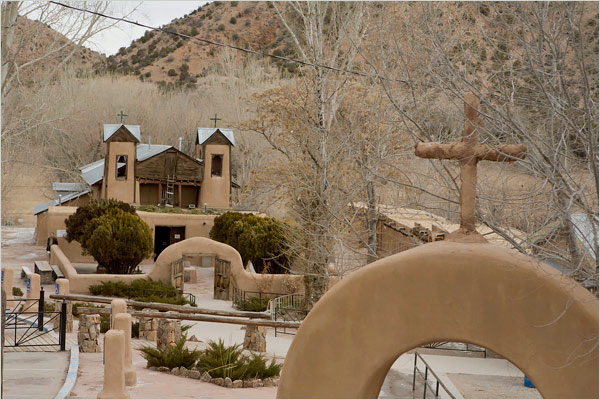True, discarded crutches line a wall inside the Santuario de Chimayo, a small adobe
church in this village of northern New Mexico known as the Lourdes of America.
True, tens of thousands of pilgrims walk eight miles or more to the shrine on Good
Friday, some bearing heavy crosses and others approaching on their knees. Scores of people
visit every day the rest of the year, many hoping to cure diseases or disabilities with
prayer, holy water and, most famously, the healing dirt, which visitors collect from a
hole in the floor inside the church.
Now the disparagement of the dirt was jarring, coming from Father Roca, who has devoted
much of his life to creating the present-day shrine and is its revered eminence. At 89, he
wears a beret that reveals his Barcelona origins.
Some 50 years ago, he took over the abandoned, nearly ruined site of the church, which
was first constructed in 1816. He oversaw the rebuilding of the sanctuary — holy hole
included — into the spotless place it is today, with bright paintings and statues
inside and giant cottonwoods out back that he planted as saplings. It has become a stop
for tour buses taking the scenic route to Taos as well as for local residents in search of
solace or cures, and was declared a national landmark in 1970. Visitors bring their own
baggies or containers or can buy little plastic containers marked “blessed dirt”
at the church’s gift shop.
Few leave without some of the reddish soil, scooped from the 18-inch-wide
“posito,” or well, that is continually replenished — by a caretaker, Father
Roca is quick to explain, despite rumors over the years that the pit was refilled by
divine intervention.
He pointed to the small building nearby where trucked-in dirt is stored. “I even
have to buy clean dirt!” he complained.
Some people take dirt away for divine luck, while those with ailments may eat it, brew
it in tea or rub it on the afflicted body area.
On a chilly February morning, Rosa and Ben Salazar of nearby San Pedro, both 78,
visited the Santuario to pray and replenish their supplies of holy water and dirt.
“We’ve had miracles here,” Mrs. Salazar said. They have stepped up their
visits since her husband was found to have cancer. “He has spots on his lungs, and
the doctor originally said he would have to have chemotherapy,” she said.
“We come here all the time to pray,” she said, and at home they rub the dirt
on her husband’s chest and feet. And, lo, after his latest CAT scan, Mrs. Salazar
said, the doctor told them that he looked better and that chemotherapy might not be needed
after all.
Father Roca believes in miracles, too, but, he said, “They are the work of the
Good Lord.”
“I always tell people that I have no faith in the dirt, I have faith in the
Lord,” he said. “But people can believe what they want.”
Father Roca prefers to direct attention to the six-foot-tall wooden crucifix above the
main altar, and he happily recounts its fabled history.
On a dark Good Friday in 1810, according to legend, men from the secretive Penitente
Brotherhood were engaged in rites on a hill above Chimayo — whether
self-flagellation, a crucifixion of a chosen member or just prolonged prayer is not clear.
One of them, Don Bernardo Abeyta, saw a strange light shining upward from the valley.
When the men went down to investigate, the light disappeared but at its source they
discovered a half-buried wooden crucifix. They sent for the nearest priest, 10 miles away
in Santa Cruz, who had the crucifix taken in a happy procession to his parish church. But
the next morning it was gone and had reappeared at the spot where the men initially found
it.
This happened three times, the legend goes, before everyone got the message. Don Abeyta
built a small chapel for the crucifix at the discovery site in the valley, which,
historians note, had been a sacred area for Pueblo Indians. Soon, word began to spread
that this was a place for the lame and the blind to be healed. Today’s dirt hole is
said to be on the spot where the crucifix was found, accounting for its supposed power and
the continued faith of visitors even if they know the dirt is brought in from outside.
Father Roca said there was evidence that the crucifix had been brought to the area
originally by a Guatemalan priest and from early on, it was called Our Lord of Esquipulas,
after a major shrine in Guatemala.
As for the dirt, the best-known attraction of his busy little church, he said: “I
don’t like to think about it. People come here not for the crucifix but for the dirt,
and some people even sell it.”
Mrs. Salazar, the believer in its healing power, said she knew nothing of Father
Roca’s vexation. “I think the dirt gets blessed by the priests, doesn’t
it?” she asked.
SOURCE: http://www.nytimes.com/2008/02/20/us/20dirt.html?th&emc=th



